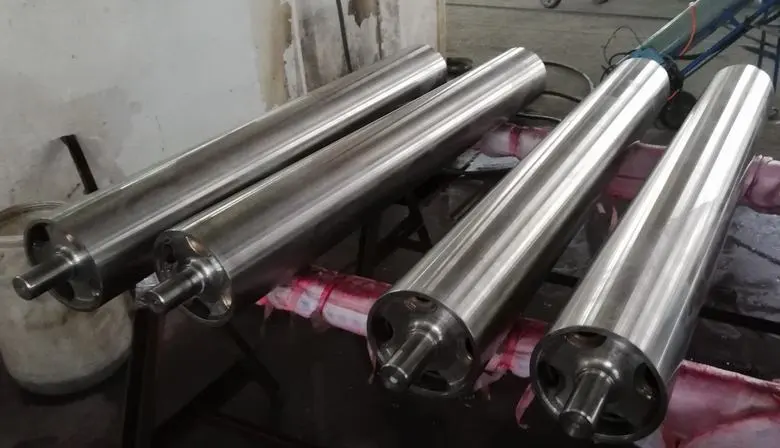Types and Applications of Stabilizer Rolls
Common Types of Stabilizer Rolls
Stabilizer rolls come in various types, each designed to meet specific industry requirements. Some common types include:
- Grooved Stabilizer Rolls: These rolls feature precision-machined grooves on their surface, which help to reduce air entrainment and improve web contact.
- Smooth Surface Stabilizer Rolls: Ideal for delicate materials, these rolls have a polished surface to minimize friction and prevent damage to sensitive webs.
- Rubber-Covered Stabilizer Rolls: These rolls have a rubber coating that provides enhanced grip and helps to dampen vibrations.
- Ceramic-Coated Stabilizer Rolls: Known for their durability and resistance to wear, these rolls are often used in high-speed applications.
Industries Utilizing Stabilizer Rolls
Stabilizer rolls find applications across numerous industries, including:
- Paper and Pulp Manufacturing: Used in paper machines to control web tension and improve sheet formation.
- Plastic Film Production: Essential for maintaining film flatness and preventing wrinkles during extrusion and lamination processes.
- Textile Manufacturing: Employed in fabric finishing lines to ensure consistent tension and prevent distortion.
- Printing and Converting: Used in printing presses and converting equipment to maintain precise web alignment and tension control.
- Metal Processing: Applied in steel and aluminum processing lines to stabilize metal strips during coating and finishing operations.
Advantages of Using Stabilizer Rolls
The implementation of stabilizer rolls offers several benefits to manufacturing processes:
- Improved Product Quality: By maintaining consistent web tension and flatness, stabilizer rolls help reduce defects and enhance overall product quality.
- Increased Production Speeds: The stability provided by these rolls allows for higher production speeds without compromising quality.
- Reduced Material Waste: By preventing web breaks and minimizing wrinkles, stabilizer rolls help reduce material waste and improve yield.
- Enhanced Process Control: The precise tension control offered by stabilizer rolls allows for better overall process control and consistency.
- Extended Equipment Life: By reducing vibration and wear on other machine components, stabilizer rolls can help prolong the life of production equipment.
Design and Construction of Stabilizer Rolls
Materials Used in Stabilizer Roll Manufacturing
The choice of materials for stabilizer roll construction is critical to their performance and longevity. Common materials include:
- Stainless Steel: Offers excellent corrosion resistance and durability, making it suitable for harsh environments.
- Aluminum: Provides a lightweight option for applications requiring lower inertia and faster speed changes.
- Carbon Fiber: Utilized in high-speed applications where minimal weight and maximum stiffness are required.
- Composite Materials: Engineered combinations of materials that can be tailored to specific performance requirements.
The selection of material depends on factors such as the operating environment, required surface properties, and the specific needs of the manufacturing process.
Engineering Considerations in Stabilizer Roll Design
Designing an effective stabilizer roll involves careful consideration of several engineering factors:
- Roll Diameter and Length: These dimensions are critical in determining the roll's inertia and its ability to maintain consistent contact with the web.
- Surface Finish: The texture and treatment of the roll surface directly impact its interaction with the material being processed.
- Balance and Alignment: Precision balancing and alignment are essential to minimize vibration and ensure uniform pressure distribution.
- Bearing Selection: High-quality bearings are crucial for smooth operation and long service life.
- Deflection Control: Design features such as internal supports or cambered rolls may be employed to minimize deflection under load.
Manufacturing Processes for Stabilizer Rolls
The production of high-quality stabilizer rolls involves several sophisticated manufacturing processes:
- Precision Machining: CNC lathes and mills are used to achieve the tight tolerances required for optimal roll performance.
- Surface Treatment: Techniques such as chrome plating, ceramic coating, or specialized texturing are applied to enhance surface properties.
- Dynamic Balancing: Advanced balancing equipment is used to ensure the roll operates smoothly at high speeds.
- Quality Control: Rigorous testing and inspection procedures are implemented to verify dimensional accuracy and performance characteristics.
- Custom Engineering: Many stabilizer rolls are custom-designed to meet specific application requirements, involving close collaboration between manufacturers and end-users.
Maintenance and Optimization of Stabilizer Rolls
Regular Maintenance Procedures
Proper maintenance is essential for ensuring the longevity and optimal performance of stabilizer rolls. Key maintenance procedures include:
- Routine Inspection: Regular visual and mechanical inspections to detect signs of wear, damage, or misalignment.
- Cleaning: Removing debris and contaminants that may accumulate on the roll surface or in bearings.
- Lubrication: Ensuring proper lubrication of bearings and other moving components to reduce friction and wear.
- Surface Refurbishment: Periodically refinishing or resurfacing the roll to maintain optimal surface characteristics.
- Vibration Analysis: Using vibration monitoring tools to detect early signs of bearing wear or balance issues.
Performance Optimization Techniques
To maximize the effectiveness of stabilizer rolls in production processes, consider the following optimization techniques:
- Proper Alignment: Ensuring precise alignment of stabilizer rolls within the production line to maintain uniform web tension.
- Speed Matching: Adjusting roll speeds to match web speed, minimizing friction and potential for web damage.
- Tension Control: Implementing advanced tension control systems to maintain optimal web tension throughout the process.
- Environmental Control: Managing ambient temperature and humidity to prevent thermal expansion issues and maintain consistent roll performance.
- Data Analysis: Utilizing process data to identify trends and optimize roll settings for different material types and production conditions.
Troubleshooting Common Issues
When problems arise with stabilizer rolls, quick identification and resolution are crucial. Common issues and their solutions include:
- Web Wrinkles: May indicate improper tension or roll misalignment. Adjust tension settings and check roll alignment.
- Inconsistent Web Tension: Could be caused by worn bearings or uneven roll surface. Inspect and replace bearings if necessary, and consider resurfacing the roll.
- Vibration: Often a sign of balance issues or bearing problems. Perform dynamic balancing and check bearing condition.
- Surface Wear: Accelerated wear may indicate improper material selection or excessive pressure. Evaluate material compatibility and adjust operating parameters.
- Web Breakage: Can result from excessive tension or sharp edges on the roll surface. Review tension settings and inspect roll surface for damage.
In conclusion, stabilizer rolls are indispensable components in many industrial processes, contributing significantly to product quality and production efficiency. Their design, construction, and maintenance require specialized knowledge and precision engineering. By understanding the principles behind stabilizer roll operation and implementing best practices in their use and maintenance, manufacturers can optimize their production processes and achieve superior results. For more information on stabilizer rolls and other industrial components, please contact us at info@welongpost.com.
References
- How Does a Stabilizer Roll Control Web Tension? - Knowledge. Welong Casting. (2024, February 1).
- Stabilizer Rolls & Deflector Rolls: Unraveling Their Role in Industrial Processes. Alok Alloys. (2023, October 30).
- Performance enhancement of the roll stabilization systems used in industrial applications. AIP Conference Proceedings. (2023, November 8).
- Kocurek, M. J., & Wong, K. K. (1989). Web handling and winding: tension control. TAPPI Press.
- Brown, J. L. (2020). Web handling basics. TAPPI Press.
- Michaeli, W., & Scharf, D. (2012). Plastics processing data handbook. Hanser Publications.




